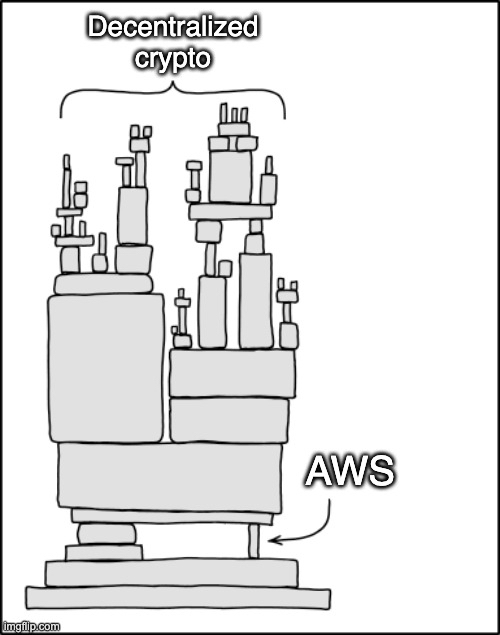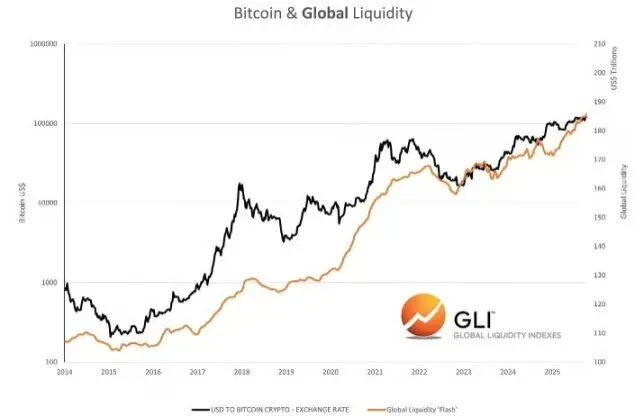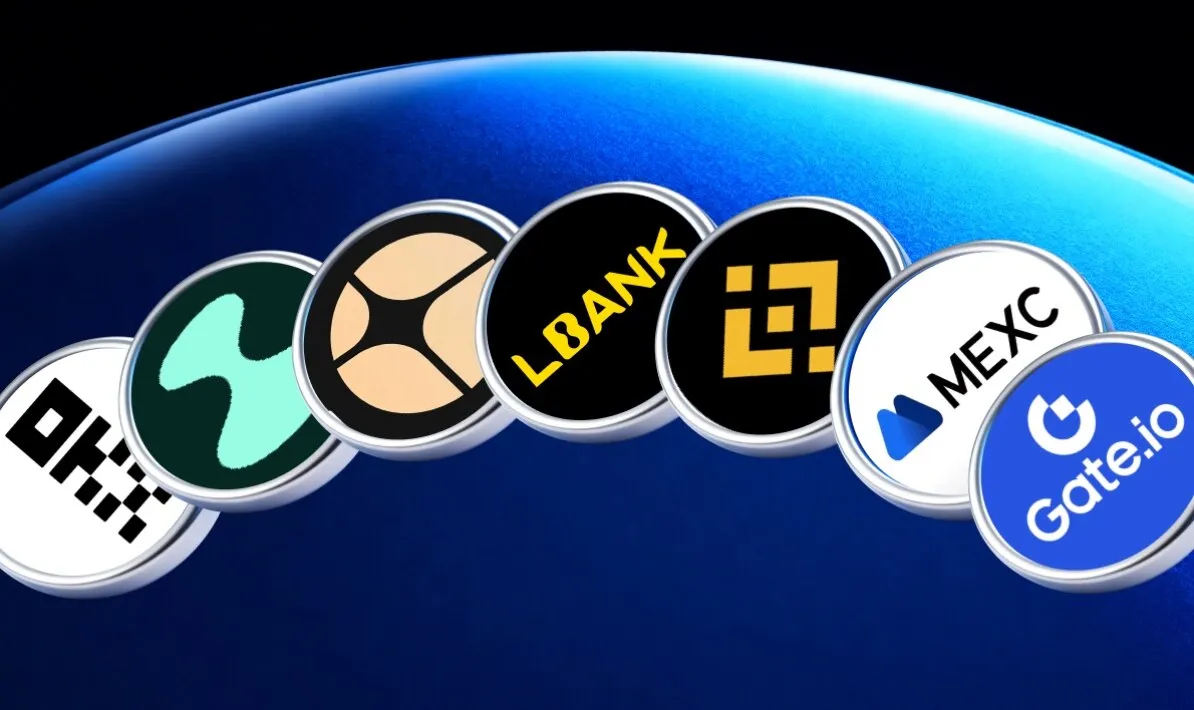Author: Rekt
Translation: Deep Tide TechFlow
October 20, 2025: AWS (Amazon Web Services) US-EAST-1 region goes down.

Coinbase freezes trading, Robinhood experiences outages, Infura interrupts MetaMask connections.Layer 2 networks such as Polygon, Optimism, Arbitrum, Base, Linea, and Scrollall go offline within minutes.
ManFromHell bluntly stated: "AWS is down, half of the crypto industry is paralyzed. Today's 'decentralized' atmosphere is off the charts."
Ethereum continues to produce blocks, while Bitcoin runs smoothly.
The blockchain itself did not crash—however, exchanges went offline, wallet connections were interrupted, and users were locked out of "decentralized" finance due to a DNS failure from a single cloud service provider.
An industry that was supposed to eliminate trust in third parties has proven it cannot survive without relying on Jeff Bezos to keep things running.
When your "anti-censorship revolution" comes to a halt because Amazon's servers fail, who is the real master?
Sources: AWS, CryptoSlate, ManFromHell, Skipper, The Register, Decrypt, Ethernodes, CoinTelegraph, Statista, FinanceFeeds, U Today, Vet, Lefteris Karapetsas, MattFlint, Carla, Gracy Chen, LexisNexis, Concept Board, Akash, ICP
Infura is the infrastructure service supported by Consensys that connects MetaMask to the blockchain,reports indicate that whenAWScrashed, Polygon, Optimism, Arbitrum, Linea, Base, and Scroll all experienced interruptions.
At 3:11 AM Eastern Time, when the DynamoDB endpoint in Amazon's US-EAST-1 region experienced a DNS resolution failure, Infura's status page was instantly covered in red alerts.
Ethereum mainnet JSON-RPC API: Down. Polygon: Down. Optimism, Arbitrum, Linea, Base, Scroll: Fully down.
Six so-called "decentralized" Layer 2 networks simultaneously went down, because they all relied on the same centralized pipeline to connect with users.
During the AWS outage,MetaMask users were unable to access Ethereum and Layer 2 networks, causing transactions to stall and dapp interfaces to become unresponsive.
This was not due to issues on-chain—validator nodes were still validating, blocks were still being produced—but because the paths to these chains depended on a company's servers, which operated on Amazon's infrastructure.
Coinbase and its Base application highlighted the irony of centralization in cryptocurrency.
During the AWS outage,both the Coinbase app and Base were temporarily unavailable, preventing users from logging in, buying, selling, or withdrawing cryptocurrency.
The company acknowledged the issue and stated it was actively "restructuring services" to prevent similar outages from occurring again—essentially admitting that its infrastructure is not as decentralized as advertised.
Meanwhile, approximately 2,368 Ethereum execution nodes are located on AWS infrastructure, accounting for nearly 37% of the total network.
While this is not enough to halt the blockchain, it is sufficient to prevent most users who do not run their own nodes from accessing it.
If decentralized systems need to rely on centralized infrastructure to operate, what exactly are we decentralizing?
A Familiar Script
April 15, 2025: AWS experienced "connection issues." Binance suspended withdrawals, and KuCoin went offline. MEXC, Gate.io, Coinstore, DeBank, Rabby Wallet—at least eight platforms reported service interruptions within minutes.
Six months later, almost the same script played out again.
AWS controls about 30% of the global cloud market, Microsoft Azure holds 20%, and Google Cloud Platform accounts for 13%.
Amazon, Microsoft, and Google control 63% of internet infrastructure, which includes the vast majority of the cryptocurrency's "decentralized" ecosystem.
Binance operates on AWS. So does Coinbase. BitMEX, Huobi, Crypto.com, and Kraken are all closely tied to Amazon's infrastructure to meet user demands for low latency and high-capacity transaction processing. When Amazon has issues, the giants of the crypto industry fall one after another.
ManFromHell's tweet** is not an exaggeration, but a fact.**
But the real difference lies in who is truly decentralized: the XRP Ledger did not stop producing blocks during either outage.
Validators are distributed across AWS, Google Cloud, Hetzner, DigitalOcean, and independent servers, meaning that no single point of failure can disrupt the network.
"This is the hard work of decentralization, especially in terms of geographic and host distribution," contributor Vet pointed out.
Distributed infrastructure does work—provided you are willing to pay the price and intentionally build it. But most projects have not done so.
How many more outages will it take for "decentralization" to transform from a marketing term into an engineering necessity?
A Wake-Up Call for the Crypto Industry
"When AWS goes down, the internet collapses. But the blockchain never will… wait, let me take that back. This industry is a joke. Everyone is touting decentralization and anti-censorship, but in reality… it relies 100% on cloud services." — Lefteris Karapetsas, founder of Rotkiapp
"Platforms that promote 'decentralization' were taken down by a centralized cloud service. The irony: extraordinary." —MattFlint summarized the thoughts of countless people about Coinbase in one sentence.
"If an AWS outage affects your cryptocurrency, then it is neither decentralized nor currency. Bitcoin is, not cryptocurrency." — Carla, a Bitcoin extremist, stated the truth that protocol purists have been shouting for years.
Lefteris Karapetsas threw down a hammer of criticism: "The entire vision behind blockchain is decentralized infrastructure, but we are not achieving that at all."
Not "in progress," nor "being realized," but failed.
Gracy Chen, CEO of Bitget exchange, stated during the AWS service outage in April this year: "AWS data center issues affected multiple centralized exchanges—no need to panic. This reminds us: perhaps it's time to explore decentralized cloud services."
Six months later, this statement still holds true.
Dr. Max Li, CEO of OORT, proposed a well-known but rarely paid-for solution: "Decentralized cloud computing offers a powerful alternative by distributing data and processing across the network, reducing the risk of single points of failure."
Coinbase strongly opposed this, announcing it was "restructuring services" to prevent future service interruptions. In other words, they finally admitted that their architecture contradicts their marketing.
This outage did not directly impact the market, but it changed people's perceptions.
The conversation suddenly shifted to alternatives—what decentralization should look like if someone actually builds it.
Smart investors will not just complain about centralization but will bet on alternatives.
When the marketing finally aligns with the infrastructure, will anyone remember what decentralization was supposed to mean?
Why Some Choose the Easy Path
Running your own node means needing to purchase expensive hardware, ensure stable power, maintain sufficient bandwidth, and hire professionals who truly understand the technology.
AWS provides the same services at an extremely low cost andpromises 99.99% uptime along with the reliability of infrastructure that Amazon has built over twenty years.
For startups with limited funds eager to go live, this is simply incomparable, as there are not many options.
Multi-cloud strategies are more expensive, self-hosting requires teams to possess expertise that most projects lack; while geographic redundancy can lead to latency issues, which are particularly sensitive for traders in the crypto industry.
All philosophical positions on decentralization ultimately have to face the harsh reality of cloud computing economics: centralized infrastructure is cheaper, faster, and "good enough"—until it isn't.
Most projects choose speed over sovereignty. You can't blame them. Try explaining to venture capitalists why you need to invest twice as much in infrastructure for the sake of principle.
But there is another angle that no one wants to discuss: the CLOUD Act (Clarifying Lawful Overseas Use of Data Act).
U.S. law grants authorities the power to require U.S. cloud providers to provide data, regardless of where that data is actually located.
Whether that data is on European servers or Asian data centers, as long as it is hosted on AWS, Azure, or Google Cloud, U.S. law enforcement can access it with the appropriate legal authorization, without needing approval from foreign courts.
This reality complicates the crypto industry's narrative about "anti-censorship," especially when much of its infrastructure relies on servers bound by U.S. government data requests.
European regulators increasingly view the dominance of U.S. cloud computing as a sovereignty issue, with some authorities warning against using U.S. cloud services to handle sensitive data.
Decentralization promises to free us from institutional control.
However, most crypto infrastructure ultimately falls under the control of three companies, which in turn must answer to one government.
If your "trustless" system needs to rely on Amazon not cooperating with law enforcement, how "trustless" is it really?
The Convenient Hidden Costs
Multi-cloud is not a complicated thing.
Expand your infrastructure toAWS,Azure, and Google Cloud. Add geographic redundancy outside of US-EAST-1.
Accept higher costs and complexity as the price of actual resilience.
XRP Ledger proves its effectiveness. Validator nodes are distributed across multiple service providers, allowing it to maintain normal operation even when other networks go down.
This is not because XRP Ledger has better technology, but because it made different architectural choices and paid for redundancy.
Decentralized alternatives do exist, but they remain on the fringes:
Filecoin,IPFS, and Arweaveoffer decentralized storage.
Akash Networkprovides decentralized cloud computing.
Internet Computer Protocol (ICP)promises full-stack decentralization.
However, these technologies are still relatively early in their development and have low adoption rates. Developers tend to use the tools they are familiar with, and what they are familiar with is AWS.
Two weeks after the April outage, Vanar specifically launched Neutron to address this dependency issue.
CEO Jawad Ashraf stated: "This unlocks new possibilities: from storing files entirely on-chain without relying on third parties to querying and verifying actual information within files."
Possibilities. Potential. Maybe one day.
Meanwhile, every project faces the same choice: rent services from big companies and accept systemic risk; or build truly decentralized infrastructure and accept higher costs.
There is no middle ground. You either rely on centralized providers or you do not.
Most people choose to rely because it is cheaper now, ignoring the losses that will occur when Amazon'sDNS has issues tomorrow.
How many hundreds of millions in assets need to be frozen before "temporarily" becomes unacceptable?
Ethereum continues to produce blocks, and Bitcoin remains unaffected. On October 20, 2025, no blockchain truly collapsed—protocols operated exactly as designed.
What failed was the access layer, and this failure exposed the dirtiest secret of the crypto industry: you can verify transactions, but ifAWS controls the permission to submit your transactions, your sovereignty is merely superficial.
Two major outages within six months. The same root cause, different regions.
This pattern will not disappear because the incentive structure has not changed—centralized infrastructure remains cheaper and simpler, so projects choose it despite knowing the risks.
The crypto industry is built on the principle of "don't trust, verify," yet it heavily relies on trusting that three companies will not go down.
An industry that was supposed to free itself from institutional gatekeepers has handed the keys to the largest gatekeeper on the planet.
When the infrastructure layer is still centralized, decentralization at the protocol level is meaningless.
The next AWS service outage is coming. Then the next one, and the one after that. Each will trigger the same Twitter outrage, the same promises to do better, and the same return to convenient choices after the crisis.
The crypto industry must adapt—adopt multi-cloud strategies, geographic redundancy, and truly decentralized alternatives—or admit that "decentralization" has merely been a slightly different facade for the same centralized systems.
When Amazon's next DNS failure prevents you from accessing your "self-hosted" wallet, will you still believe in a "trustless" system?
免责声明:本文章仅代表作者个人观点,不代表本平台的立场和观点。本文章仅供信息分享,不构成对任何人的任何投资建议。用户与作者之间的任何争议,与本平台无关。如网页中刊载的文章或图片涉及侵权,请提供相关的权利证明和身份证明发送邮件到support@aicoin.com,本平台相关工作人员将会进行核查。




